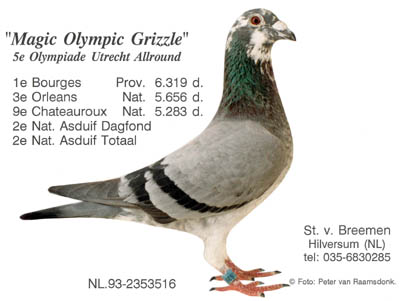
Nature and the behavior of the pigeons 
Behavior of good pigeons has no fixed pattern. There are quiet, gentle ones and also mistrusting and temperamental ones. That is quite natural. We are in the first place interested in extremes. The sleepy pigeons with temperament and the lively, panicking nervous pigeons.
Beware of both. We must pay attention never to mate two sleepy or two nervous pigeons with each other. Neither does it make sense to mate a sleepy bird with a nervous one because both properties have the same cause: weak nerves. The sleepy type lacks the spark to continue. That is the type who always comes too late from a race, but in the best condition. One must get rid of this type. My experience tells me that one must always strive to liven-up the temperament with the breeding.

"Magic Olympic Grizzle" was 5th in the '95 Olympiad in Utrecht Allround and was worlds best Yearling Overall! In National competitions he finished 2nd Dayrace & 2nd Overall. In 1994 he finished 3 times in the Top Ten in National Dayraces and was 1th Ace NPO in the Dayraces. He is the son of "Bonte Jaarling"(son of "De Goede Jaarling") and "De Bourges Duivin". Four of his brothers also won in the top 5 in National Dayraces. It's all in the family!
One must be careful when pigeons become hereditarily too nervous. When they easily panic, when they fly in the face and when they climb the walls as soon as we enter the loft. This type of pigeon loses so much energy during the trip to the point of release that they are already licked at the starting signal. However I must mention that I consider the nervousness as the lesser evil of both bad properties. I have seen many good pigeons who came out of a combination of a nervous pigeon and a pigeon with a normal temperament. I consider nest love to be a further important property with pigeons. This property shows excellent at certain race points and provides many advantages. There is a close correlation between nest love and fighting spirit in my opinion. The more developed the nest love, the stronger the will to get home as soon as possible. At my own loft, where I have had, so to say, the occasion to study and test all of the world-famous strains, this property strongly emerged with the old De Smet-Matthijs pigeons. They give you bloody hands when in their nest and also in the basket they are grim, tenacious fighters. I must add that love for the nest alone without other good properties means nothing. It is a spark without a motor. Is it important how long a pigeon remains on her eggs? One cannot state that this is a good property, but what one has noticed with some pigeons is that when a partner participated in a race that she quickly leaves the nest and even the youngsters and starts a bachelor life.
I once experienced a strange happening in this regard with two hens. Namely both managed to lay eggs without a partner and to bring up two youngsters each by herself. It is obvious that no pigeon does this on her own if she has not some very special properties. Still when it concerns valuable pigeons one can consider this to be a very good sign.
Yet something else belongs to the extraordinary properties; the ability to fly in the twilight. The famous author Jan Aerts often came home late and could only feed his pigeons by lamp light. Once he noticed too late that he had turned the light off too early. He went outdoors, switched on the light again and saw that some of his pigeons had found their feed and their place in the dark, but others didn't. Stimulated by this observations, he repeated this more than often and saw that always the same pigeons knew how to get in their box in the dark. He later used this property with the selection. I believe that when a pigeon can manage this that she will become still more valuable with this added feature.
Steven van Breemen
Copyright 1998. All rights reserved. Reproduction in whole, in part, in any form or medium, without the express written permission of Steven van Breemen, is forbidden.
The whole book can be downloaded from "Winning Magazine" if you are a subscriber. You can subscribe here; costs 35 Euro for 1 year. You get 26 issues and have access to the archives with all previous published issues plus next to "The Art of Breeding" a second book written by me: "Hints for Mating, Breeding & Selection". A total bargain!